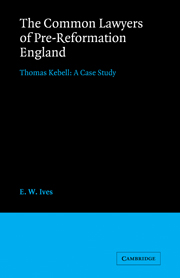Book contents
- Frontmatter
- Contents
- List of figures and tables
- Preface
- Abbreviations
- Manuscript sources
- Table of cases
- Introduction
- PART I THE LEGAL PROFESSION
- PART II LEGAL PRACTICE
- PART III THE LAWYERS AND THE LAW
- PART IV THE PROFESSION AND SOCIETY
- 13 The rewards of the profession: fees and payments
- 14 The rewards of the profession: income and morality
- 15 The rewards of the profession: the estates of Thomas Kebell
- 16 The rewards of the profession: Humberstone Manor
- 17 Social mobility: the Kebells of Humberstone
- 18 Thomas Kebell and the pre-Reformation legal profession
- Retrospect
- Appendices
- Index
17 - Social mobility: the Kebells of Humberstone
Published online by Cambridge University Press: 05 November 2011
- Frontmatter
- Contents
- List of figures and tables
- Preface
- Abbreviations
- Manuscript sources
- Table of cases
- Introduction
- PART I THE LEGAL PROFESSION
- PART II LEGAL PRACTICE
- PART III THE LAWYERS AND THE LAW
- PART IV THE PROFESSION AND SOCIETY
- 13 The rewards of the profession: fees and payments
- 14 The rewards of the profession: income and morality
- 15 The rewards of the profession: the estates of Thomas Kebell
- 16 The rewards of the profession: Humberstone Manor
- 17 Social mobility: the Kebells of Humberstone
- 18 Thomas Kebell and the pre-Reformation legal profession
- Retrospect
- Appendices
- Index
Summary
Contrasts between societies are often most complete when it comes to marriage and the family. In twentieth-century Britain, mutual attraction and dependence of husband and wife are primary, children are of consequential importance (and that for a relatively brief period), and the economic advantage of the union and the need to secure the succession rarely of any importance. The conventions of Kebell's day reversed this order.
Thomas Kebell of Humberstone, serjeant-at-law, married three times. ‘Margerie and Anne my wifes’, as he describes them in his will, were buried at Humberstone Church, while Margaret survived him, to marry again and live until 1534. About the identity of Margery there is some confusion, but the second wife is clearly known and considerable documentation exists for the third. Agnes, or, as Kebell referred to his second wife, ‘Anne’, was the daughter and heiress of Peter Saltbie and the widow of Thomas Flore of Oakham, son of Roger Flore, speaker of the house of commons in 1416, 1417, 1419 and 1422, chief steward in the north parts of the duchy of Lancaster. Thomas Flore died in 1483 and Kebell married his widow within months. Since Agnes already had two sons, Roger and Austin Flore, both of whom were remembered in the Serjeant's will, she could bring no promise of any permanent increment to the Kebell estate. However she brought to Kebell her own life interest in her inheritance and whatever Flore property she was entitled to, depending on the terms of her first marriage settlement.
- Type
- Chapter
- Information
- The Common Lawyers of Pre-Reformation EnglandThomas Kebell: A Case Study, pp. 368 - 393Publisher: Cambridge University PressPrint publication year: 1983



